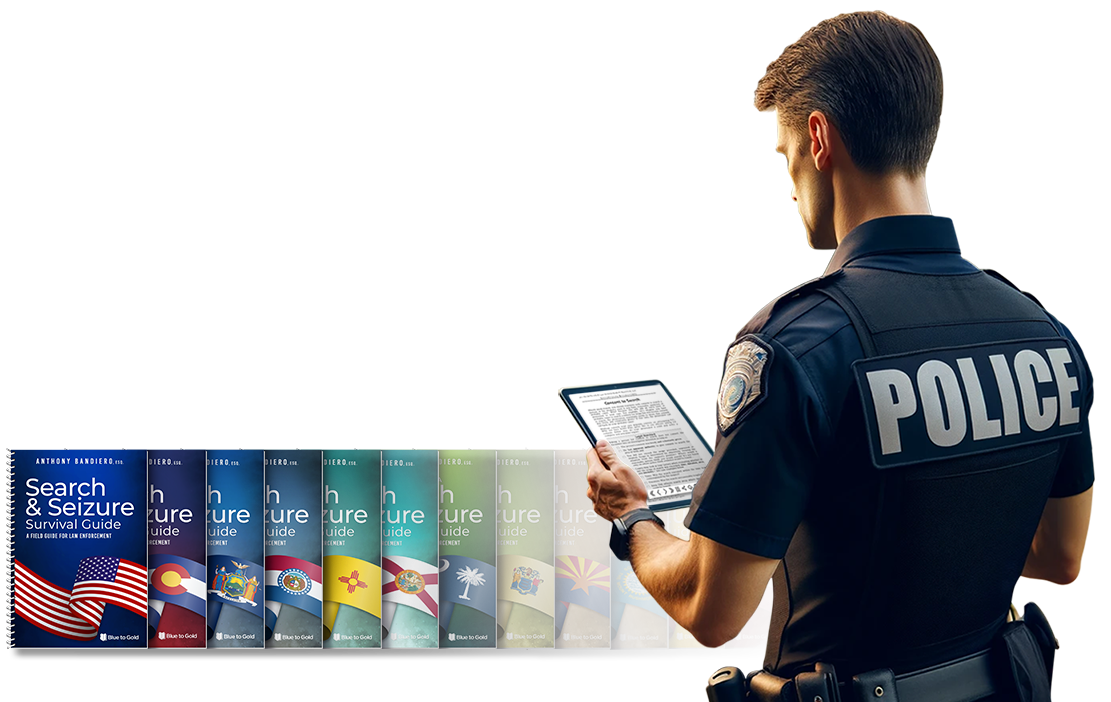Module One: Course Introduction
1. Instructor Introduction
2. Explain the course objective
3. Encourage attendees to ask questions and share feedback with other attendees.
4. Explain that certificates will be emailed after the class
5. Go over the three disclaimers:
- Laws and agency standard operating procedures may be more restrictive. Blue to Gold is teaching the federal standard unless otherwise stated. Therefore, students must know their state and local requirements in addition to the federal standard.
- If students have any doubts about their actions, ask a supervisor or legal advisor
- The course is not legal advice, but legal education. Therefore, nothing we teach should be interpreted as legal advice. Check with your agency’s legal advisor for legal advice
Module One Unprovoked Flight
1. Any refusal to cooperate, without more, does not furnish the…justification needed for a detention or seizure.” But unprovoked flight is simply not a mere refusal to cooperate. Flight, by its very nature, is not “going about one’s business”; in fact, it is just the opposite. US Supreme Court
2.
3. “A suspect’s flight at the sight of officers who are targeting him with a flashlight may provide a basis for fear of harm that has nothing to do with whether the suspect is engaged in criminal activity”. DC Appellate Court
4. Video: “Unprovoked Flight” followed by Q & A. What legal issues did you see?
5. Case Sample: The stop occurred in a high crime area, after Defendant was standing next to an idling vehicle, with the door open and fled immediately after Det. Alim called out to him. The totality of circumstances was sufficient to give rise to reasonable suspicion of criminal activity and to justify stopping and briefly detaining Defendant for further investigation. Held: we find the investigatory stop of defendant was lawful under Terry v. Ohio. State v. Rowe, 2010-Ohio-6030, 2010 WL
6.
7. Video: “Unprovoked Flight” followed by Q & A. What legal issues did you see?
Module Three: Hot Pursuits
1. Legal Rule: You may chase a fleeing suspect into their home for any arrestable offense if the chase is immediate and continuous.
2. Pro Tip: Use good judgment when chasing people for Courts will scrutinize the entire encounter, including whether violence was used to make entry. If in doubt, surround and get a warrant.
3. Hot Pursuit Examples
4. Case Sample: “Society has an interest in not rewarding the evasion of lawful police authority by allowing suspects who made it to their homes steps ahead of law enforcement officers to claim sanctuary”. Synopsis: Once inside the garage, Killpack asked Legg to come outside so that he could speak with She repeatedly stated, “I’m home.” Killpack noticed that her breath smelled of alcohol. He then gently pulled on her coat to “coax” her out of the garage. At that point he could see that her eyes were bloodshot and watery. In addition, Legg had difficulty keeping her balance and her speech was extremely slurred. When Killpack asked to see her license, Legg became angry and attempted to push the officer away from the door so she could go back inside. Killpack then told the defendant he was concerned about her intoxication and asked her to go with him to the law enforcement center. When she refused to cooperate, he placed her in handcuffs and informed her she was under arrest for operating while intoxicated (OWI). Once they arrived at the law enforcement center, Legg refused to perform field sobriety tests and refused to take a preliminary breath test. State v. Legg, 633 N.W.2d 763, 765–66
5. The arrest must begin outside the home!
6. Video: “Foot Pursuit into House” followed by Q & What legal issues did you see? What about calling for backup before entering the home?
7. Pro Tip: Officers can wait for backup if they articulate that it would not be prudent to immediately enter the residence and once backup arrives immediate entry is made
8. Case File: Drunk driving suspect fled on foot into a house. Officer called for After backup arrived police entered to house to make arrest. Synopsis: Where a police officer lost visual contact with the defendant while pursuing him through an apartment complex because he observed the defendant driving a moped illegally, and the police officer depended upon an onlooker to tell him which apartment the defendant had entered, the officer’s hot pursuit was sufficiently immediate and continuous to justify his warrantless entry into the apartment, it was decided in LaHaye v. State, 1 S.W.3d 149 (Tex. App. Texarkana 1999), petition for discretionary review refused, (Jan. 12, 2000). The officer was dispatched to an apartment complex due to a report that intoxicated persons were riding a moped. As he was nearing the complex, he saw the defendant driving a moped and noticed that the moped’s license plate light was out and the defendant was not wearing a helmet. He followed the defendant into the apartment complex parking lot and pulled in behind him. As he was getting out of his car, he asked the defendant to stop. The defendant got off the moped and let go of it. The moped fell over, hitting a parked car. After the officer told the defendant to stop, the defendant ran toward the apartment complex. The officer could not see which apartment the defendant entered, but the man who had summoned the police pointed him to the correct unit. The officer knocked on the door of the apartment, and a young lady let him in. He saw the defendant lying face down on the bed and arrested him for evading arrest. Subsequently the defendant was charged with driving while intoxicated, and, after his pretrial motion to suppress was denied, the defendant pled guilty to that offense. On appeal the defendant argued that the police officer who arrested him without a warrant was not in hot pursuit so the requisite exigent circumstances did not exist to make the warrantless entry and arrest legal. The court observed that an officer may not enter a residence and make a warrantless arrest unless a person who resides in the residence consents to the entry or exigent circumstances exist. Exigent circumstances exist, the court said, when the police are in hot pursuit of a suspect. A true hot pursuit must involve both an immediate and continuous pursuit, the court stated. The defendant argued that the officer’s pursuit of him was neither immediate nor continuous because the officer lost sight of him after he started to run toward the apartment. The test for hot pursuit does not require uninterrupted observation, the court opined. If an offender fleeing from the police turns a corner and then enters into a private residence, the pursuit is continuous and immediate even though the officer does not see the offender run into the residence. As long as the police are in the process of chasing the offender for the purpose of apprehending him for a serious crime, the court reasoned, they may enter the residence. Additionally, the court said, a suspect may not defeat an arrest that has been set in motion in a public place by escaping to a private place. The defendant attempted to evade arrest in the parking lot, the court found, and the officer pursued him in an immediate and continuous pursuit into the apartment. Under the circumstances, the court concluded, affirming the judgment of conviction, the warrantless entry and arrest were legal. Held: In Griffin v. City of Clanton, Ala., 932 F. Supp. 1359 (M.D. Ala. 1996), it was held that the police did not violate the plaintiff’s Fourth Amendment rights where the suspect driver, after being pulled over by police and failing field tests for intoxication, fled on foot approximately one block to the residence of the plaintiff, his aunt, and just as officers were about to arrest him at the plaintiff’s back door, the plaintiff opened the door and the suspect rushed inside. The officer who made the traffic stop did not immediately pursue the suspect when he fled on foot, but instead radioed for assistance, and waited for an additional officer to arrive before beginning the pursuit which ended at the plaintiff’s back door. The plaintiff alleged that the police were guilty of several, instances of misconduct following their warrantless entry into her residence to arrest the suspect, and she asserted claims against the individual officers and the city under 42 U.S.C.A. § 1983 for violation of her Fourth Amendment rights. The court noted that a warrantless entry is permissible when law enforcement officers are in hot pursuit of a fleeing suspect. The court rejected the plaintiff’s contention that by calling for assistance and remaining by his police car the officer who made the traffic stop “let the trail cool down.” The officer merely took prudent safety precautions by waiting for backup before tracking a suspect onto private residential property, the court opined. When the additional officer arrived at the scene, the original officer clearly had not lost the suspect’s trail, the court reasoned, inasmuch as he was standing in the street near the plaintiff’s house, and he told the additional officer that the suspect was on the back porch. The pursuit was so hot, the court emphasized, that the suspect had not yet gained admittance to the house even though he was banging on the back door and yelling. Concluding that the hot pursuit doctrine was applicable, the court granted the defendants’ motion for summary judgment. Held: Calling for backup, when prudent, does not eliminate hot pursuit.
9. What would you do? What if you lose sight of the suspect?
10. Pro Tip: If you lose sight of the suspect articulate that the pursuit was “continuous” while looking for him If you lost him for over +/- 15 min and track him down to his house, have another reason for the warrantless entry.
11. Case File: Drunk driving suspect fled on foot into a house. Officer called for After backup arrived police entered to house to make arrest. Synopsis: Where a police officer lost visual contact with the defendant while pursuing him through an apartment complex because he observed the defendant driving a moped illegally, and the police officer depended upon an onlooker to tell him which apartment the defendant had entered, the officer’s hot pursuit was sufficiently immediate and continuous to justify his warrantless entry into the apartment, it was decided in LaHaye v. State, 1 S.W.3d 149 (Tex. App. Texarkana 1999), petition for discretionary review refused, (Jan. 12, 2000). The officer was dispatched to an apartment complex due to a report that intoxicated persons were riding a moped. As he was nearing the complex, he saw the defendant driving a moped and noticed that the moped’s license plate light was out and the defendant was not wearing a helmet. He followed the defendant into the apartment complex parking lot and pulled in behind him. As he was getting out of his car, he asked the defendant to stop. The defendant got off the moped and let go of it. The moped fell over, hitting a parked car. After the officer told the defendant to stop, the defendant ran toward the apartment complex. The officer could not see which apartment the defendant entered, but the man who had summoned the police pointed him to the correct unit. The officer knocked on the door of the apartment, and a young lady let him in. He saw the defendant lying face down on the bed and arrested him for evading arrest. Subsequently the defendant was charged with driving while intoxicated, and, after his pretrial motion to suppress was denied, the defendant pled guilty to that offense. On appeal the defendant argued that the police officer who arrested him without a warrant was not in hot pursuit so the requisite exigent circumstances did not exist to make the warrantless entry and arrest legal. The court observed that an officer may not enter a residence and make a warrantless arrest unless a person who resides in the residence consents to the entry or exigent circumstances exist. Exigent circumstances exist, the court said, when the police are in hot pursuit of a suspect. A true hot pursuit must involve both an immediate and continuous pursuit, the court stated. The defendant argued that the officer’s pursuit of him was neither immediate nor continuous because the officer lost sight of him after he started to run toward the apartment. The test for hot pursuit does not require uninterrupted observation, the court opined. If an offender fleeing from the police turns a corner and then enters into a private residence, the pursuit is continuous and immediate even though the officer does not see the offender run into the residence. As long as the police are in the process of chasing the offender for the purpose of apprehending him for a serious crime, the court reasoned, they may enter the residence. Additionally, the court said, a suspect may not defeat an arrest that has been set in motion in a public place by escaping to a private place. The defendant attempted to evade arrest in the parking lot, the court found, and the officer pursued him in an immediate and continuous pursuit into the apartment. Under the circumstances, the court concluded, affirming the judgment of conviction, the warrantless entry and arrest were legal. In Griffin v. City of Clanton, Ala., 932 F. Supp. 1359 (M.D. Ala. 1996), it was held that the police did not violate the plaintiff’s Fourth Amendment rights where the suspect driver, after being pulled over by police and failing field tests for intoxication, fled on foot approximately one block to the residence of the plaintiff, his aunt, and just as officers were about to arrest him at the plaintiff’s back door, the plaintiff opened the door and the suspect rushed inside. The officer who made the traffic stop did not immediately pursue the suspect when he fled on foot, but instead radioed for assistance, and waited for an additional officer to arrive before beginning the pursuit which ended at the plaintiff’s back door. The plaintiff alleged that the police were guilty of several, instances of misconduct following their warrantless entry into her residence to arrest the suspect, and she asserted claims against the individual officers and the city under 42 U.S.C.A. § 1983 for violation of her Fourth Amendment rights. The court noted that a warrantless entry is permissible when law enforcement officers are in hot pursuit of a fleeing suspect. The court rejected the plaintiff’s contention that by calling for assistance and remaining by his police car the officer who made the traffic stop “let the trail cool down.” The officer merely took prudent safety precautions by waiting for backup before tracking a suspect onto private residential property, the court opined. When the additional officer arrived at the scene, the original officer clearly had not lost the suspect’s trail, the court reasoned, inasmuch as he was standing in the street near the plaintiff’s house, and he told the additional officer that the suspect was on the back porch. The pursuit was so hot, the court emphasized, that the suspect had not yet gained admittance to the house even though he was banging on the back door and yelling. Concluding that the hot pursuit doctrine was applicable, the court granted the defendants’ motion for summary judgment. Held: Losing suspect briefly does not defeat hot pursuit.
Module Four: Fresh Pursuits
1. Legal Rule: You may enter a home to arrest a violent fleeing suspect if you have reason to believe he’s dangerous, may escape, or will destroy evidence before a warrant can be obtained
2. Factos to Consider
3. Case Sample: After an armed robbery, police tracked suspects in the 45 minutes later police saw suspects inside a house and entered to make the arrest. Synopsis: Where police officers were aware that at least three, if not four, people had participated in robbery, police had learned, by looking into house, that there were more people inside than just defendant and codefendant, and neither defendant nor codefendant had any firearms on their persons when arrested, officers were justified by exigencies of circumstances and with probable cause to enter residence without warrant after defendant’s arrest outside house to search for other suspects who likely possessed weapons, instrumentalities, and evidence of robbery, in order to diminish potential for danger, escape of suspect, and destruction of evidence. State vs Campbell. Held: Arrest and plain view seizure lawful under fresh pursuit. Suspects were dangerous and cops were fresh on the suspect’s trail.
4. Case Sample: A bank robber killed a police officer and Police tracked the suspect to his apartment two hours later and entered to arrest him. Synopsis: The officers identified Gilbert and found out where he lived less than two hours after the robbery. En route to Gilbert’s apartment, agent Schlatter heard over the radio that three men were suspected of committing the robbery and that two of them had escaped in the same automobile. When Schlatter arrived at the apartment, agent Kiel told him that one of the occupants had just left. Schlatter testified that “we knew … there were three robbers. One was wounded and accounted for, one had just left a few minutes before, and there was a third unaccounted for. Presumably he was in the apartment.” Since the officers were in fresh pursuit of two robbers who escaped in the same automobile, agent Schlatter’s assumption was not unreasonable. The officers entered, not to make a general exploratory search to find evidence of guilt, but in fresh pursuit to search for a suspect and make an arrest. A police officer had been shot, one suspect was escaping, and another suspect was likely to escape. Under these circumstances the officers were not required to demand entrance and announce their purpose (Pen. Code, § 844), for to do so might have alerted the suspect and increased the officers’ peril. People vs Gilbert.
Held: Warrantless entry valid under fresh pursuit.
5. Video: “Fresh Pursuit” followed by Q & What if a witness gave you the license plate, and car was in driveway and house lights were on?
6. Video: “Fresh Pursuit in Snow” followed by Q & What legal issues did you see?
Module Five: Protective Sweeps
1. Legal Rule: There are three types of protective sweeps you may conduct during an in-home arrest.
2.
3. Video: “Hot Pursuit: El Paso” followed by Q & What legal issues did you see?
4. Pro Tip: If you can’t grab the evidence and go, you can reenter if you articulate it was necessary and continuous
Module Five Plain View Seizures
1.
2. Pro Tip: Plain View (including smell and hearing) is nothing more than right to be, right to see.
3. Pro Tip: Plain view allows you to “grab and go,” but not search for any Get a SW to search or process a scene.
4.
Module Six Takeaways











